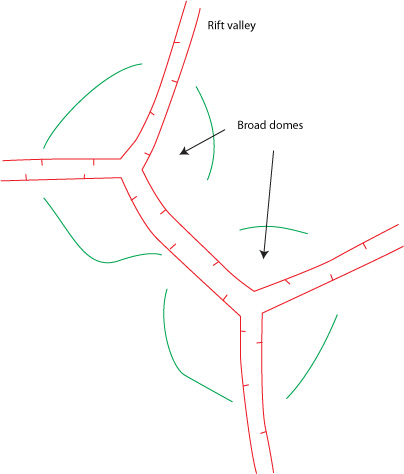
Material on this page is copyright © 2016 John W.F. Waldron
Rifts are often described as extension zones. By 'extension' we here assume that the extension direction is ~ horizontal, or parallel to stratified units, and shortening is ~ vertical.
In Anderson's theory of stress, rifts mostly fall into the "gravity regime".
In many rifts it seems that movement is roughly perpendicular to the rift axis.
Note that this is not necessarily the case. When rifting is oblique then the strain is more complicated: we refer to the deformation in an oblique rift as transtension. (Note: despite the way it sounds, 'transtension' is not a dynamic term but a kinematic term; it describes a style of deformation, not a style of stress.)
The most influential example in the present-day world is the East African Rift, which shows the follwing features:
Many of these features are explained by thinning of the lithosphere.
Lithospheric stretch is typically represented by
β = (new width)/(original width).
If stretching is orthogonal and uniformly distributed through the crust, and volume is conserved, it's also possible to write
β = (original thickness)/(new thickness)
Thinning of the lithosphere brings the hot asthenosphere closer to the surface, typically leading to low degrees of partial melting as the pressure is reduced. The resulting igneous rocks are alkali basalt and related compositions. These hot mafic magmas may melt the overlying crust, producing granite. Bimodal assemblages of igneous rocks - mafic and felsic - typify rifts.
The characteristic topography of rifts is an isostatic response to high heat flow (produces regionally elevated surface), coupled with the localized thinning of the axial region (produces the rift valley).
About 30% of the world's giant oilfields are in rifts!
A continental rift may evolve into:
Hence most passive continental margins overlie buried rifts. Another 30% of the world's conventional oil is in passive continental margins.
Many of the features covered in this section are common to faults in all tectonic environments. However, because rifts are well studied, and because the amount of strain in a rift is often small, many characteristics of faults are best studied, and best known, in rift environments.
In a previous section we describe the processes that take place during fracture propagation.
Griffith cracks - microscopic cracks, mostly along grain boundaries - are present in all geological materials. Griffith cracks oriented at high angles to σ3 tend to open as differential stress increases.
Thus a zone of microfracture opening exists around the tip of a propagating fault, where it is known as the process zone or frictional breakdown zone.
Stress is then concentrated at the tips of the extensional cracks, which are able to grow until they join up to form a through-going shear fractures, along which slip can begin.
As slip increases the process zone advances ahead of the fault tip. Deformation in the process zone may include multiple small fractures, small granular shear zones called deformation bands, and/or ductile structures like folds, distributed through a broad swath of rock.
As the tip of the main fault advances, it cuts through the process zone. The two halves of the process zone tend to be preserved in a damage zone on either side of the fault core.
In the fault core, which may consist of breccia, cataclasite, gouge or even pseudotachylite, the prexisting structure of the rock cannot be traced.
In the damage zone, original features of the rock (e.g. bedding) may still by followed, but are typically offset by subsidiary fractures and/or folds.
Common types of fracture orientations preserved in damage zones include:
The fractures themselves may be regular smaller faults if the rock is non-prorous, but in a porous rock such as sandstone it is common to see an abundance of deformation bands in the damage zone. Deformation bands are small shear zones where deformation has utilized pore space in the rock to allow grain rearrangment.
It has been shown that fault damage zones tend to become wider as slip occurs. This means that they are not solely due to phenomena in the process zone at the fault tip. The most likely explanation is that most faults are not perfectly straight; they have irregularities known as asperities. The movement of these asperities against the opposite wall of a fault produces stresses that widen the damage zone.
In map view these faults show decreasing heave towards fault tips at either end. (Heave is the horizontal component of the fault offset.)
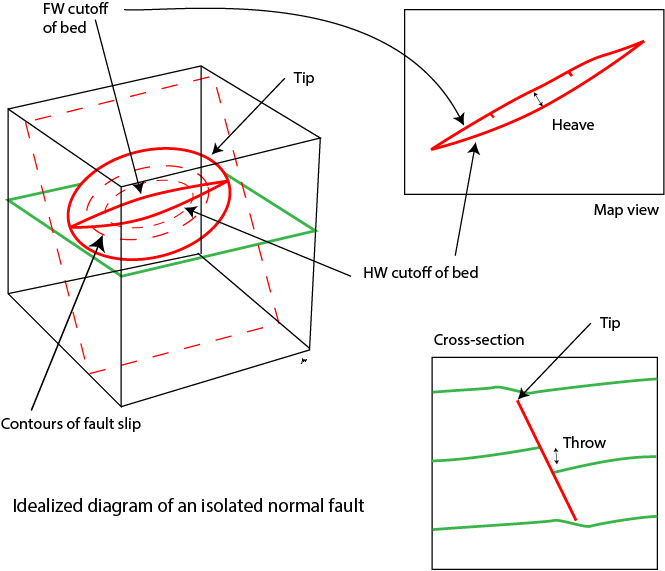
In general, the width (distance between tip points) of a fault trace increases as displacement increases.

As faults develop, fragmented wall rocks are spread along the fault plane as breccia, cataclasite, or gouge, depending on the grain size. Breccia and cataclasite tend to be permeable whereas gouge can be impermeable if it's clay-dominated. Determining the permeability of faults may be critical in reservoir development. Fault permeability in can often be predicted by calculating gouge ratios.
At points on a fault where gouge ratio exceeds 20% there is a high chance that the fault will seal adjacent porous units.
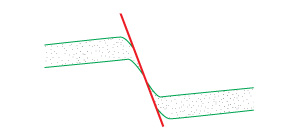
As a fault tip propagates through a sediment package, it may be preceded by a zone of creep deformation. This may be preserved in the walls of the fault as a drag fold. (The name drag fold is a poor one because the folding probably occurs before faulting; it would be better to call these fault propagation folds by analogy with structures in thrust belts.)
Folds showing the opposite kinematics to drag folds are common adjacent to normal faults. This phenomenon used to be referred to as 'reverse drag' but is now commonly known as 'rollover'.
Rollover is a variety of fault-bend folding. To see how rollover works, consider a normal fault with concave-up and convex-up segments. To maintain strain compatibilty, the hanging wall must deform to accomodate changes of shape in the footwall.
There is a close relationship between folding of the beds and the shape of the fault.
Flats tend to be overlain by anticlines and the ramps by synclines.
In detail, the relationship depends on the type of strain developed in the hangingwall as it accommodates to the footwall.
The simplest assumption is of vertical simple shear.
If the horizontal component of displacement is h (for heave) then we can make a construction called the Chevron construction, that enables us to predict the fault trace from the bedding trace or vice versa.
For example, given this geometry...
The lengths t1 t2 t3... can be used to reconstruct the thickness of the hanging wall and thus fix the shape of the fault.
Other possible models include simple shear on some other plane: e.g. a conjugate plane to the main fault.
Fault-bend folds related to listric normal faults are very important as petroleum traps in a number of fields on passive margins, including both margins of the Atlantic. Several big fields including Hibernia have this general geometry.
If there is sedimentation in an area of active normal faulting the thicknesses of units change across the faults. This is known as growth and the faults are called growth faults.

The sediment pattern in half-grabens is particularly characteristic.
There are excellent examples in the virtual seismic atlas.

Within a basin isolated faults may overlap in arrangement, and displacement is transferred from one fault to another through zones of ductile deformation. In cross-section these produce a variety of geometries, including some that are commonly described as 'drag folds'
In 3 dimensions, gentle folding in such zones produces relay ramps between one fault and the next.
Eventually, as strain increases, faults link up along such overlap zones to produce an array of interconnected faults.
Displacement maps may still indicate where the original faults in a system nucleated.
Many common configurations of normal faults are variations on the theme of conjugate faults: multiple normal faults in 2 families, with ~60° angle between them.
Smaller faults may be described as synthetic and antithetic in relation to larger faults
Normal faults bound horsts and grabens. A tilted block bounded by a normal fault on one side is a half graben.
In general, there is also a tendency for normal faults to flatten into shear zones at depth, producing listric geometries, though the extent of flattening in individual rifts may be controversial. Tilting may be explained either by listric faults or by fault blocks that behave like books on a shelf.
Interconnected faults with the same overall sense of dip may connect to form an extensional duplex.
At larger scale rifts vary from symmetric to asymmetric
In symmetric rifts, lower crustal deformation is probably approximately coaxial, pure shear
In asymmetric rifts ('Wernicke' model) simple shear occurs at depth. The locus of lower crustal extension may be displaced from the upper crustal rift. Highest heatflow and volcanic activity may be offset from rift axis.
Sense of asymmetry may shift along strike, producing transfer zones
If rifting ceases without the development of an ocean basin (sometimes called a failed rift or aulacogen) thermal subsidence may lead to development of a steer's head basin that has two parts, a fault-bounded rift basin and an overlying sag basin.
Subsidence rates after the end of rifting gradually slow, exponentially. There is a relationship between post-rift subsidence rate and the stretching factor β.
Predicted subsidence curves for different beta - from Allen and Allen
Passive continental margins are margins of continents that do not coincide with a plate boundary. A pair of passive continental margins forms when rifting gives way to ocean-floor spreading. Passive margins are also called 'rifted margins' or 'Atlantic-type margins'
In addition to the 30% of the world's giant oilfields that are contained in rifts, passive margin post-rift successions contain about another 30%; thus 60% or more of the world's oil is located in rifts and passive margins.
Passive continental margins are rift remnants, left behind when sea-floor spreading starts.
Diagrams showing evolution from rift to passive margin
Passive continental magins characteristically subside because the heat source is removed to the new spreading centre.
Characteristically, passive margins show:
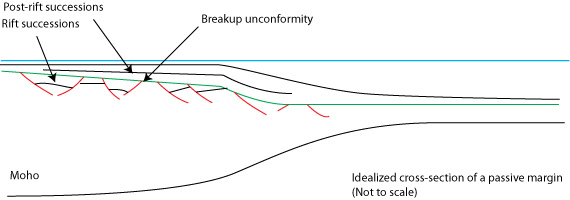
Passive margins typically show an initial rapid phase of subsidence (rift phase) followed by a period in which the subsidence curve is ~exponential, with gradually slowing subsidence. There is a relationship between post-rift subsidence rate and the stretching factor β.
Predicted subsidence curves for different beta - from Allen and Allen
As in a failed rift, it's possible to predict the cooling rate (and therefore the subsidence rate) associated with a given amount of crustal thinning. Hence it's possible to take a subsidence curve and calculate how much the crust must have been extended.
Restoration by backstripping can be used to determine the geometry of a passive margin basin at some point in the past. This can be useful for modelling the evolution of petroleum systems. The steps may vary depending on assumptions about the basin history but typically include:
The exact steps vary depending on
When conjugate margins - those that face each other across a new ocean - are examined in detail there may be differences between the two sides that are inherited from the initial rift, indicating that the rift itself was asymmentric (a "Wernicke style" rift). We can distinguish:
Some passive margins show long distance (10s of km) gravity slides of large sediment sheets.
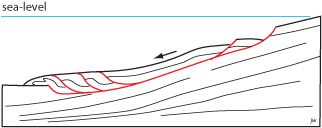
The up-slope areas show structures similar to those of asymmetric rifts
Down-slope region shows thrust belt structures
Particularly large slides are known from the Niger delta off Africa where the structures are potentially petroleum bearing.
Rifts in tropical climates may accumulate thick evaporite deposits. As spreading occurs, these evaporites may undergo mobilization within the passive margin succession under the influence of gravity.
Halokinesis refers to the movement of salt.
Halokinesis is typically due to:
Tendency of salt to flow from place to place can be measured by hydraulic head, which comprises two parts

Styles of flow in salt layers
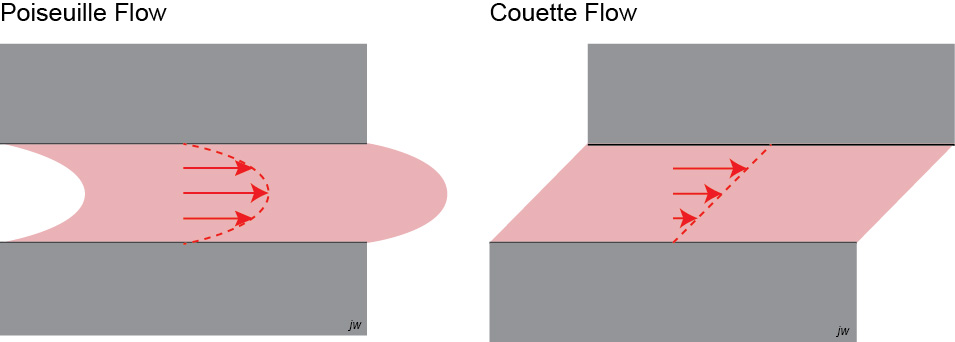
A diapir is any body of salt or other evaporites that rises within the crust. (The term is also applied to igneous intrusions.) Halokinesis that leads to the formation of diapirs is known as diapirism.
We recognize several dynamic effects that can start salt moving in a passive continental margin setting.
These effects combine to produce a number of geometries
Salt expulsion features
